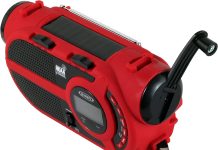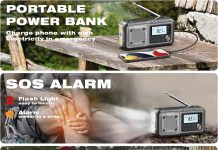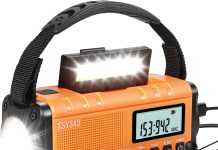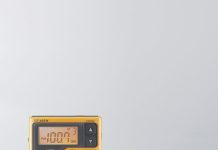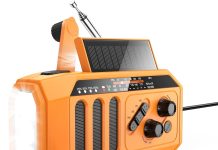Are you concerned about staying informed during emergencies? In this article, we will explore the simple steps to set up emergency notifications on your radio. Whether you’re an outdoor enthusiast, a parent looking to ensure your family’s safety, or just want to stay connected in times of crisis, this guide will provide you with the information you need to configure your radio for emergency alerts. Don’t let potential emergencies catch you off guard — read on to learn how to stay informed with your radio.
Review contents
Choosing the Right Radio
When it comes to emergency notifications, having the right radio can make a world of difference. There are a few key considerations to keep in mind when selecting a radio for emergency notifications.
Considerations for Emergency Notifications
First and foremost, it’s crucial to choose a radio that is capable of receiving emergency notifications. Look for radios that are specifically designed for emergency use or have emergency notification features.
Another important consideration is the range of the radio. Depending on where you live or frequently travel, you’ll want to ensure that the radio has a sufficient range to receive emergency notifications in your area.
Durability is also key. In emergency situations, your radio may need to withstand rough conditions or extreme weather. Look for radios that are built to be rugged and withstand the elements.
Features to Look for in a Radio
When it comes to emergency notifications, there are a few features that can greatly enhance your ability to stay informed. Look for radios that offer NOAA Weather Radio capabilities. These radios can receive weather alerts and updates directly from the National Oceanic and Atmospheric Administration.
Another useful feature to consider is Specific Area Message Encoding (SAME). This technology allows you to program your radio to receive alerts for specific geographic areas of interest. It ensures that you only receive notifications that are relevant to your location.
Additionally, radios with an alarm function can be very helpful. These radios can emit a loud alarm tone when an emergency notification is received, even if the radio is turned off. This can serve as a crucial safety feature, ensuring you are alerted to emergencies even while you’re asleep or away from the radio.
Understanding Emergency Notifications
Before setting up emergency notifications on your radio, it’s important to have a basic understanding of what they are and why they are crucial for your safety.
Types of Emergency Notifications
Emergency notifications can come in various forms, including weather alerts, Amber Alerts, and other emergency messages. Weather alerts are particularly important, as they can provide timely information about severe weather conditions, such as tornadoes or flash floods.
Amber Alerts, on the other hand, are emergency notifications issued specifically in cases of child abductions. These alerts help mobilize communities to aid in the safe recovery of abducted children.
Importance of Being Prepared
Emergency notifications play a vital role in keeping communities safe and informed during emergencies. By receiving timely alerts, individuals can take necessary precautions, evacuate if required, or seek shelter. Being prepared and having a radio capable of receiving emergency notifications ensures that you are always in the know when it comes to potential dangers.
Registering for Emergency Notifications
Before you can start receiving emergency notifications on your radio, it may be necessary to register with a local agency responsible for sending out these alerts.
Local Agency for Emergency Notifications
The first step in registering for emergency notifications is to identify the local agency that handles these alerts in your area. This could be your county’s emergency management agency, a local law enforcement agency, or a state agency responsible for emergency alerts.
Contacting the local agency will not only help you register for emergency notifications but also ensure that you have accurate information specific to your area.
Signing up for Emergency Alerts
Once you have identified the local agency, find out what methods they use to distribute emergency notifications. Some agencies may use traditional methods like television and radio, while others may utilize phone calls, text messages, or even smartphone apps.
Follow the instructions provided by the agency to sign up for emergency alerts. You may need to provide your contact information, address, or other relevant details. It’s important to keep this information up to date, as any changes could impact your ability to receive timely notifications.
Setting up Emergency Notifications on Your Radio
Now that you’re registered for emergency notifications, it’s time to set up your radio to receive them.
Identifying the Alert System
Different radios may utilize different alert systems. Take the time to familiarize yourself with the specific alert system used by your radio. This information can usually be found in the user manual provided with your radio or on the manufacturer’s website.
Understanding the alert system is crucial, as it ensures that you know what to expect when an emergency notification is received.
Enabling Emergency Notifications on Your Radio
To enable emergency notifications on your radio, you will typically need to access the settings menu. Look for an option related to emergency alerts or notifications.
Once you’ve found the appropriate setting, ensure that it is enabled. Depending on your radio, you may also have the option to adjust notification settings, such as the volume or the types of alerts you want to receive.
Tuning to the Correct Frequency
To receive emergency notifications, it’s important to tune your radio to the correct frequency.
Finding the Frequency for Emergency Notifications
The frequency for emergency notifications can vary depending on your location. In the United States, most emergency notifications are broadcasted on NOAA Weather Radio frequencies. These frequencies can typically be found in the range of 162.400 MHz to 162.550 MHz.
To find the specific frequency for your area, consult the user manual or the manufacturer’s website for your radio. Alternatively, you can also reach out to the local agency responsible for emergency notifications.
Programming the Frequency on Your Radio
Once you have identified the correct frequency, it’s time to program it into your radio. Refer to the user manual or the manufacturer’s instructions for detailed steps on how to program frequencies.
Typically, this involves selecting the appropriate channel or frequency on your radio and saving it as a preset. Ensure that the saved frequency is easily accessible, so you can quickly tune in when an emergency notification is received.
Testing Emergency Notifications
While setting up your radio for emergency notifications is essential, regular testing is equally important to ensure that everything is functioning properly.
Importance of Regular Testing
Regular testing helps you verify that your radio is capable of receiving emergency notifications and that you have programmed it correctly. It also gives you confidence in the reliability of the system and your ability to be alerted in case of an emergency.
Performing a Test of the Emergency Notification System
To test the emergency notification system, wait for a scheduled test alert or contact the local agency responsible for emergency notifications. They can provide guidance on how to test the system and verify that it is working correctly.
During the test, confirm that you receive the alert on your radio and that it functions as expected. If any issues arise, consult the user manual or reach out to the manufacturer or the local agency for assistance.
Customizing Emergency Notifications
Every individual’s needs and preferences may vary, and fortunately, most radios allow for customization of emergency notifications.
Adjusting Notification Settings
Depending on the capabilities of your radio, you may be able to adjust the notification settings according to your preferences. For example, you might be able to select the types of alerts you wish to receive or adjust the volume at which they are played.
Take the time to explore the settings menu of your radio and adjust the notifications to suit your needs. Remember to strike a balance between being alerted to emergencies and avoiding unnecessary interruptions.
Scheduling Quiet Hours
In situations where regular alerts might be disruptive, such as during sleeping hours, some radios allow you to schedule quiet hours. This feature ensures that emergency notifications do not disturb you during specific times of the day or night.
By customizing your emergency notifications, you can strike a balance between staying informed and maintaining your daily routine.
Maintaining Your Radio for Emergency Notifications
To ensure that your radio is always ready to receive emergency notifications, it’s essential to perform regular maintenance and checks.
Regular Battery Checks
One of the most important aspects of maintaining your radio is regularly checking the battery. Make it a habit to check the battery status and replace or recharge batteries as needed. In emergencies, having a fully charged battery is crucial to ensure uninterrupted communication.
Consider investing in rechargeable batteries and a battery charger. This will not only save you money in the long run but also help reduce waste and environmental impact.
Keeping the Radio Updated
Just like any other technology, radios may require periodic updates to ensure optimum performance. Check the manufacturer’s website or contact their customer support to inquire about firmware updates or any other recommended maintenance procedures.
Staying up to date with the latest software and firmware updates will help ensure that your radio remains capable of receiving emergency notifications and any potential performance enhancements.
Staying Informed during Emergencies
Having emergency notifications on your radio is just one piece of the puzzle when it comes to staying informed during emergencies. It’s important to rely on multiple sources of information for a comprehensive understanding of the situation.
Sources of Emergency Information
During emergencies, it’s crucial to seek information from reliable and official sources. In addition to emergency notifications received on your radio, consider tuning into local television and radio stations, checking official government websites, and following social media accounts of relevant agencies.
Additionally, if you have access to the internet, there are numerous websites and apps that provide live updates on emergencies, weather conditions, and other critical information.
Interpreting Emergency Notifications
Interpreting emergency notifications accurately is essential for taking appropriate actions. Emergency notifications often provide specific instructions or guidance on how to respond to the situation.
Take the time to familiarize yourself with the various types of emergency notifications and their meanings. This will help you understand the severity of the situation and respond accordingly to ensure your safety.
Conclusion
Setting up emergency notifications on your radio is a crucial step in being prepared for emergencies. By selecting the right radio, registering for notifications, tuning to the correct frequency, testing the system, and customizing the settings, you can ensure that you are always informed and ready to respond to emergencies. Regular maintenance and staying informed through multiple sources further enhance your ability to stay safe and protect yourself and your loved ones during critical situations. Remember, being prepared is the first step towards staying safe!


